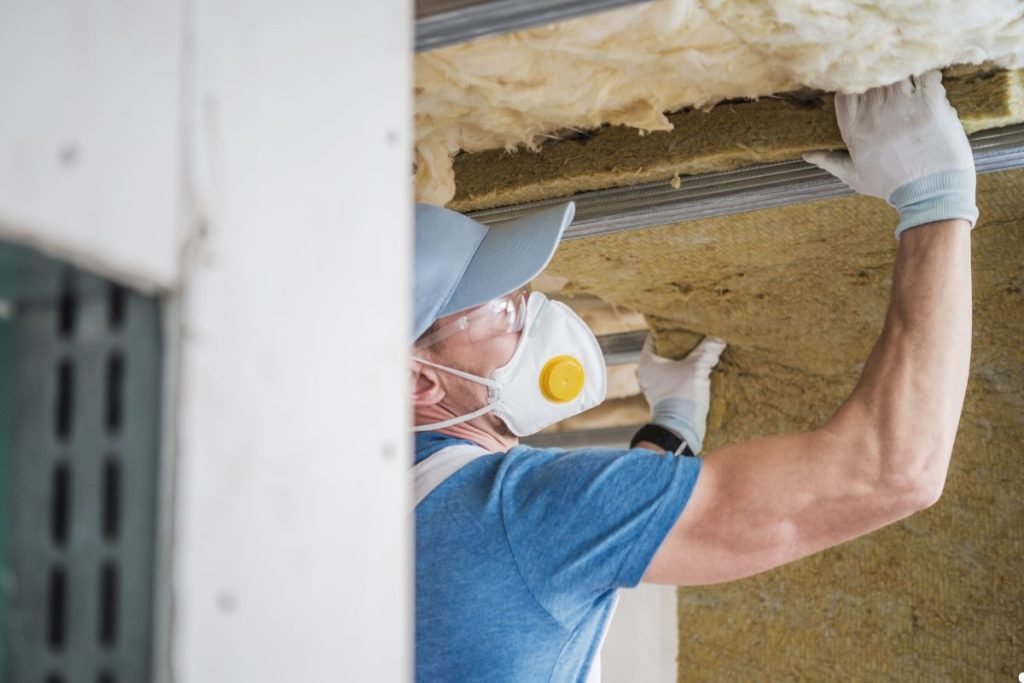
Spray foam insulation is a premium insulation and air sealant material that significantly boosts your home’s energy efficiency, increases comfort, and can lower your monthly utility bills. By creating an effective thermal barrier and stopping air leaks, it helps maintain consistent temperatures year-round, making it a smart investment for homeowners across the USA looking for long-term performance and savings. This guide covers everything you need to know about spray foam insulation. Call us today to learn more or schedule your free consultation!
What is Spray Foam Insulation?
Spray foam insulation, often referred to as SPF (Spray Polyurethane Foam), is a chemical product created by combining two liquid components – typically isocyanate and polyol resin. When mixed and sprayed on-site by a professional installer using specialized equipment, these liquids react, expand rapidly (up to 30-100 times their liquid volume), and cure to form a rigid or semi-rigid foam. This expanded foam fills gaps, cracks, and crevices completely, serving a dual purpose: it provides excellent thermal insulation (resisting heat flow) and acts as a highly effective air barrier, preventing drafts and air leakage which are major sources of energy loss in homes. Its primary goal is to create a more comfortable, energy-efficient indoor environment. Professional installers apply spray foam wall insulation on-site, ensuring a custom fit that enhances indoor comfort year-round.

Are you a San Antonio homeowner looking for a cost-effective way to improve your home’s comfort and lower your energy bills? Fiberglass insulation is a popular choice, and for good reason! This guide will walk you through everything you need to know about fiberglass insulation, from understanding its benefits and types to making the right choice for your home and budget.
Understanding the Types: Open-Cell vs. Closed-Cell Foam
Not all spray foam is created equal. There are two main types, and choosing the right one depends on your specific needs, budget, and where it will be installed in your home.
Open-Cell Spray Foam
Open-cell spray foam has a lower density (around 0.5 pounds per cubic foot) and a sponge-like appearance. Its cells are intentionally left open.
- R-Value: Typically offers an R-value of around R-3.5 to R-4.5 per inch.
- Expansion: Expands significantly upon application, excellent for filling large cavities completely.
- Air Barrier: Effective air sealant.
- Vapor Permeability: It is vapor permeable, meaning moisture can pass through it. In colder climates, a separate vapor barrier might be needed.
- Sound Dampening: Offers excellent sound absorption qualities.
- Cost: Generally less expensive than closed-cell foam.
- Common Uses: Attics (applied to the roof deck underside in some climate zones), wall cavities, soundproofing interior walls.
Closed-Cell Spray Foam
Closed-cell spray foam is much denser (around 1.75 – 2 pounds per cubic foot or more) and rigid. Its cells are completely closed and packed tightly together.
- R-Value: Offers a higher R-value, typically R-6.0 to R-7.5 per inch, providing more insulation power in less space.
- Expansion: Expands less dramatically than open-cell.
- Air Barrier: Excellent air sealant.
- Vapor Barrier: Acts as its own vapor barrier (retarder) when applied at sufficient thickness (usually 1.5-2 inches), resisting moisture transfer.
- Structural Strength: Adds structural rigidity to wall assemblies and roof structures.
- Cost: More expensive than open-cell foam due to more material used and higher performance.
- Common Uses: Basement walls, crawl spaces, rim joists, exterior applications, areas requiring high R-value in limited space, and situations where moisture resistance is critical.
Top Benefits of Choosing Spray Foam Insulation
Investing in spray foam insulation offers numerous advantages for US homeowners:
- Superior Energy Efficiency: With high R-values and exceptional air sealing, SPF significantly reduces heat transfer and air leaks, leading to lower energy consumption for heating and cooling.
- Lower Utility Bills: Reduced energy use translates directly into noticeable savings on your monthly heating and cooling costs.
- Enhanced Home Comfort: Say goodbye to drafts and inconsistent temperatures. Spray foam helps maintain a stable, comfortable environment throughout your home, regardless of the season.
- Improved Indoor Air Quality: By sealing cracks and gaps, SPF prevents dust, pollen, pollutants, and allergens from entering your home from attics, crawl spaces, or outside.
- Noise Reduction: Both types of foam, especially open-cell, are effective at dampening airborne sound, creating a quieter indoor space.
- Pest Deterrence: The rigid seal created by spray foam makes it difficult for insects and rodents to enter your home through tiny openings.
- Increased Structural Strength (Closed-Cell): Closed-cell foam acts like a glue, adding rigidity and strength to wall and roof structures.
- Moisture Management (Closed-Cell): Closed-cell foam resists water absorption and can help prevent moisture-related issues like mold and mildew when properly applied.
How is Spray Foam Insulation Installed?
Spray foam insulation installation is not a DIY project for most homeowners; it requires specialized equipment, safety gear, and technical expertise. Here’s a general overview of the professional process:
- Site Preparation: The area is prepped, which involves clearing obstructions, masking off windows, doors, and fixtures, and ensuring adequate ventilation.
- Safety Measures: Installers wear extensive personal protective equipment (PPE), including respirators, full body suits, and gloves, as the chemical components can be hazardous during application. Occupants typically need to vacate the premises during and shortly after installation.
- Equipment Setup: Hoses are run from a truck or trailer containing the chemical drums and proportioning equipment that heats and mixes the two components.
- Application: The trained technician sprays the liquid mixture onto the target surfaces (wall studs, roof deck, rim joists, etc.).
- Expansion and Curing: The foam rapidly expands to fill the cavity and then cures, hardening into its final form. Curing times vary depending on the product and conditions.
- Trimming (If Necessary): Excess foam that expands beyond studs or joists may need to be trimmed flush to allow for drywall or other finishes.
- Cleanup: The crew removes masking materials and cleans the work area.
Understanding Spray Foam Insulation Costs
The cost of spray foam insulation is typically higher upfront compared to traditional insulation like fiberglass or cellulose. However, its long-term energy savings and performance often result in a favorable return on investment (ROI). Costs are usually calculated per “board foot” (one square foot at one-inch thickness). Factors influencing the final price include:
- Type of Foam: Closed-cell foam is generally more expensive per board foot than open-cell foam due to higher material density and performance.
- Required Thickness (R-Value): The desired R-value dictates the necessary thickness, directly impacting material volume and cost.
- Project Size: The total square footage of the area being insulated is a major cost factor. Larger projects may have a lower cost per square foot but a higher overall price.
- Accessibility: Difficult-to-reach areas (tight crawl spaces, complex attic structures) may increase labor time and cost.
- Preparation Work: Costs for removing old insulation, cleaning, or making repairs before spraying will add to the total price.
- Labor Rates: Installation costs vary based on regional labor markets.
Spray Foam vs. Other Insulation Types (Fiberglass, Cellulose)
How does spray foam stack up against common alternatives?
- R-Value per Inch: Closed-cell SPF offers the highest R-value (R-6 to R-7.5). Open-cell SPF (R-3.5 to R-4.5) is comparable to dense-pack cellulose and slightly better than standard fiberglass batts (R-3.1 to R-3.8).
- Air Sealing: Spray foam is unique in that it insulates and air seals in one step, significantly outperforming fiberglass and cellulose (which require separate air sealing measures for optimal performance). This is a major advantage for energy efficiency.
- Moisture Resistance: Closed-cell foam is highly resistant to moisture and acts as a vapor barrier. Open-cell foam is vapor permeable. Fiberglass and cellulose can absorb and hold moisture if they get wet, potentially leading to mold and reduced R-value.
- Installation: Spray foam requires professional installation. Fiberglass batts and blown-in fiberglass/cellulose can be DIY projects, although professional installation is often recommended for best results.
- Longevity: Spray foam doesn’t settle, sag, or compress over time, maintaining its R-value for the life of the building. Fiberglass and cellulose can settle or degrade, potentially losing effectiveness.
Finding the Right Spray Foam Insulation Contractor
Choosing a qualified and reputable contractor is crucial for a successful spray foam installations. Look for:
- Licensing and Insurance: Ensure the contractor is properly licensed to operate in your area and carries adequate liability and workers’ compensation insurance.
- Experience and Training: Ask about their experience specifically with spray foam and if their technicians are trained and certified (e.g., through the Spray Polyurethane Foam Alliance – SPFA).
- References and Reviews: Check online reviews and ask for references from previous customers.
- Detailed Quotes: Get written quotes that clearly outline the scope of work, type of foam being used, thickness (target R-value), total cost, warranty information, and safety procedures.
- Safety Protocols: A reputable contractor will prioritize safety, explaining the procedures for protecting your home and ensuring proper ventilation and re-entry times. Don’t choose based on price alone; quality and safety are paramount.

Frequently Asked Questions About Spray Foam Insulation
Here are answers to some common questions homeowners have:
Is spray foam insulation safe?
Once cured, spray foam insulation is generally considered safe and stable (inert). The primary safety concerns are during the application process due to the chemicals involved. Professional installers use specific safety protocols, including respiratory protection and ventilation, and homeowners typically need to vacate the property for a recommended period (often 24-72 hours) until it’s fully cured and ventilated. With our services, your property will be in expert hands, guaranteeing a safe and thorough spray foam insulation application.
How long does spray foam insulation last?
Spray foam insulation is very durable. When installed correctly, it doesn’t shrink, sag, or settle over time. It typically lasts for the life of the building, maintaining its insulating properties and air seal integrity for decades.
Can I install spray foam insulation myself?
While small DIY spray foam kits exist (often for sealing small cracks), insulating large areas like attics or walls is strongly discouraged for DIYers. Professional installation requires expensive specialized equipment for proper mixing, heating, and application, extensive safety precautions due to chemical exposure risks, and expertise to ensure correct thickness and coverage for optimal performance and safety. Improper installation can lead to poor results, odors, and potential health hazards.
Does spray foam insulation off-gas?
Spray foam does release volatile organic compounds (VOCs) and odors during the application and curing process – this is why ventilation and vacating the premises are critical. Once fully cured (typically within 24-72 hours), off-gassing significantly decreases, and modern foams are formulated to be stable and safe long-term. Reputable installers use products meeting safety standards and ensure proper installation to minimize any lingering issues.
Ensure your home’s safety and air quality with professionally installed spray foam insulation. Contact us today for expert guidance and a worry-free installation experience.
Where can spray foam insulation be used in a home?
Spray foam is versatile and can be used in many areas, including:
- Attics (underside of roof deck or attic floor)
- Crawl spaces (walls and rim joists)
- Basement walls (interior or exterior)
- Rim joists (between floor levels)
- Exterior walls (new construction or major renovations)
- Cantilevered floors
- Around windows and doors to seal gaps
Is Spray Foam Insulation Right for Your Home?
Spray foam insulation represents a significant upgrade over traditional insulation methods, offering unmatched air sealing capabilities and high R-values that lead to substantial energy savings, improved home comfort, and better indoor air quality. While the initial investment is higher, the long-term benefits, durability, and performance make it a compelling choice for many US homeowners looking to create a more efficient and comfortable living space.
Consider your home’s specific insulation needs, problem areas (drafts, high energy bills, moisture issues), and budget. If you value long-term performance, energy efficiency, and superior comfort, spray foam insulation is likely an excellent investment. Call us today to schedule a free consultation and find out how spray foam can transform your home’s comfort and efficiency!
